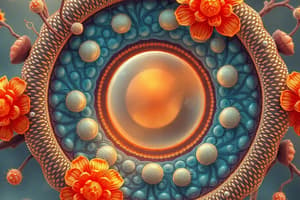Podcast
Questions and Answers
What is the main function of the eukaryotic cell membrane?
What is the main function of the eukaryotic cell membrane?
- To enclose the cell and define its boundaries (correct)
- To maintain essential differences between the cytosol and the extracellular environment
- To form a continuous double layer about 5 nm thick
- To provide electrical insulation for nerve cell axons
What is the primary role of lipid molecules in the cell membrane?
What is the primary role of lipid molecules in the cell membrane?
- Act as an impermeable barrier to water-soluble molecules
- Maintain essential differences between the cytosol and the extracellular environment
- Perform specific tasks within the membrane
- Provide the basic fluid structure (correct)
What is the characteristic feature of all lipid molecules in the cell membrane?
What is the characteristic feature of all lipid molecules in the cell membrane?
- Amphiphilic (amphipathic) (correct)
- Soluble in water and charged
- Highly variable amounts and types in different membranes
- Impermeable to water-soluble molecules
What is the approximate percentage of lipid molecules in the mass of animal cells?
What is the approximate percentage of lipid molecules in the mass of animal cells?
Which type of membrane protein performs most of the membrane's specific tasks?
Which type of membrane protein performs most of the membrane's specific tasks?
What is a common characteristic of all membrane proteins?
What is a common characteristic of all membrane proteins?
Which type of cell membrane has less than 25% protein by mass?
Which type of cell membrane has less than 25% protein by mass?
How do lipid molecules assemble in the cell membrane?
How do lipid molecules assemble in the cell membrane?
What is the approximate number of lipid molecules in the plasma membrane of a small animal cell in a 1µm area?
What is the approximate number of lipid molecules in the plasma membrane of a small animal cell in a 1µm area?
What is the main characteristic of hydrophilic end of lipid molecules in the cell membrane?
What is the main characteristic of hydrophilic end of lipid molecules in the cell membrane?
What is the approximate ratio of lipid molecules to protein molecules in the cell membrane (CM)?
What is the approximate ratio of lipid molecules to protein molecules in the cell membrane (CM)?
Which of the following is NOT a function of membrane proteins?
Which of the following is NOT a function of membrane proteins?
What is the role of hydrophobic regions of transmembrane proteins?
What is the role of hydrophobic regions of transmembrane proteins?
How are peripheral membrane proteins bound to the membrane?
How are peripheral membrane proteins bound to the membrane?
What is the function of nuclear pores?
What is the function of nuclear pores?
Which structure contains almost all of the cell’s hereditary information?
Which structure contains almost all of the cell’s hereditary information?
What is the role of rough endoplasmic reticulum (Rough ER) in liver cells?
What is the role of rough endoplasmic reticulum (Rough ER) in liver cells?
What is the approximate size of a nucleosome?
What is the approximate size of a nucleosome?
Flashcards are hidden until you start studying
Study Notes
- The eukaryotic cell membrane is a dynamic fluid structure that encloses the cell and maintains the boundary between the cytosol and extracellular environment.
- Membrane structure is a thin film of lipid and protein molecules held together by non-covalent interactions.
- Lipid molecules are the basic building blocks of membranes, forming a continuous double layer about 5 nm thick. They provide impermeability to water-soluble molecules and assemble spontaneously into bilayers.
- Lipids make up about 50% of the mass of animal cells and there are approximately 5x10^6 lipid molecules per 1µm^2 of lipid bilayer.
- Membrane proteins give each type of cell membrane its specific functional properties. There are both transmembrane and peripheral membrane proteins.
- Transmembrane proteins have hydrophobic regions that pass through the membrane and interact with lipids, while hydrophilic regions are exposed to water. Some proteins are covalently attached to lipids for increased hydrophobicity.
- Peripheral membrane proteins are bound to either face of the membrane by non-covalent interactions. They can be released by gentle extraction procedures or by exposure to solutions of very low or high ionic strength or extreme pH.
- The nucleus is the largest structure in the cell and contains almost all of the cell's hereditary information. It is surrounded by a double membrane and has nuclear pores that control substance movement.
- Nuclear DNA consists of 165 bp of DNA and 8 histone molecules, forming a nucleosome, which is a repeating unit of DNA and histone proteins.
- Chromatin, which is the threadlike appearance of DNA when not reproducing, becomes short and thick during cell division to form chromosomes.
- The endoplasmic reticulum is an extensive network of membranous sacs and tubules that is continuous with the nuclear envelope. It has rough and smooth surfaces, with rough ER being studded with ribosomes and smooth ER synthesizing enzymes and lipids.
Studying That Suits You
Use AI to generate personalized quizzes and flashcards to suit your learning preferences.




